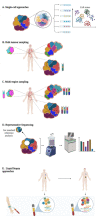Deciphering Tumour Heterogeneity: From Tissue to Liquid Biopsy
- PMID: 35326534
- PMCID: PMC8946040
- DOI: 10.3390/cancers14061384
Deciphering Tumour Heterogeneity: From Tissue to Liquid Biopsy
Abstract
Human solid malignancies harbour a heterogeneous set of cells with distinct genotypes and phenotypes. This heterogeneity is installed at multiple levels. A biological diversity is commonly observed between tumours from different patients (inter-tumour heterogeneity) and cannot be fully captured by the current consensus molecular classifications for specific cancers. To extend the complexity in cancer, there are substantial differences from cell to cell within an individual tumour (intra-tumour heterogeneity, ITH) and the features of cancer cells evolve in space and time. Currently, treatment-decision making usually relies on the molecular characteristics of a limited tumour tissue sample at the time of diagnosis or disease progression but does not take into account the complexity of the bulk tumours and their constant evolution over time. In this review, we explore the extent of tumour heterogeneity with an emphasis on ITH and report the mechanisms that promote and sustain this diversity in cancers. We summarise the clinical strikes of ITH in the management of patients with cancer. Finally, we discuss the current material and technological approaches that are relevant to adequately appreciate ITH.
Keywords: circulating tumour DNA; liquid biopsy; multi-region sampling; next-generation sequencing; single-cell approaches; treatment resistance; tumour heterogeneity.
Conflict of interest statement
The authors declare no conflict of interest.
Figures




Similar articles
-
Genetic intra-tumour heterogeneity in epithelial ovarian cancer and its implications for molecular diagnosis of tumours.J Pathol. 2007 Feb;211(3):286-95. doi: 10.1002/path.2112. J Pathol. 2007. PMID: 17154249
-
Tumour Cell Heterogeneity.F1000Res. 2016 Feb 29;5:F1000 Faculty Rev-238. doi: 10.12688/f1000research.7210.1. eCollection 2016. F1000Res. 2016. PMID: 26973786 Free PMC article. Review.
-
Intratumour heterogeneity in urologic cancers: from molecular evidence to clinical implications.Eur Urol. 2015 Apr;67(4):729-37. doi: 10.1016/j.eururo.2014.04.014. Epub 2014 May 2. Eur Urol. 2015. PMID: 24836153 Review.
-
Intra-Tumour Genetic Heterogeneity and Prognosis in High-Risk Neuroblastoma.Cancers (Basel). 2021 Oct 15;13(20):5173. doi: 10.3390/cancers13205173. Cancers (Basel). 2021. PMID: 34680323 Free PMC article.
-
Leveraging single-cell sequencing to unravel intratumour heterogeneity and tumour evolution in human cancers.J Pathol. 2022 Jul;257(4):466-478. doi: 10.1002/path.5914. Epub 2022 May 23. J Pathol. 2022. PMID: 35438189 Free PMC article. Review.
Cited by
-
Engineering Heterogeneous Tumor Models for Biomedical Applications.Adv Sci (Weinh). 2024 Jan;11(1):e2304160. doi: 10.1002/advs.202304160. Epub 2023 Nov 9. Adv Sci (Weinh). 2024. PMID: 37946674 Free PMC article. Review.
-
Circulating Micro-RNAs Predict the Risk of Recurrence in Triple-Negative Breast Cancer.Cells. 2024 Nov 14;13(22):1884. doi: 10.3390/cells13221884. Cells. 2024. PMID: 39594632 Free PMC article.
-
The development and applications of circulating tumour cells, circulating tumour DNA and other emerging biomarkers for early cancer detection.Explor Target Antitumor Ther. 2025 May 13;6:1002314. doi: 10.37349/etat.2025.1002314. eCollection 2025. Explor Target Antitumor Ther. 2025. PMID: 40385463 Free PMC article. Review.
-
Optimizing ctDNA: An Updated Review of a Promising Clinical Tool for the Management of Uveal Melanoma.Cancers (Basel). 2024 Sep 1;16(17):3053. doi: 10.3390/cancers16173053. Cancers (Basel). 2024. PMID: 39272911 Free PMC article. Review.
-
Intratumor Heterogeneity and Treatment Resistance of Solid Tumors with a Focus on Polyploid/Senescent Giant Cancer Cells (PGCCs).Int J Mol Sci. 2023 Jul 16;24(14):11534. doi: 10.3390/ijms241411534. Int J Mol Sci. 2023. PMID: 37511291 Free PMC article. Review.
References
-
- Bignold L.P., Coghlan B.L.D., Jersmann H.P.A., editors. David Paul von Hansemann: Contributions to Oncology: Context, Comments and Translations. Birkhäuser; Basel, Switzerland: 2007. Hansemann’s Ideas of the Nature of Cancer: Description and Analysis; pp. 75–90.
Publication types
LinkOut - more resources
Full Text Sources

